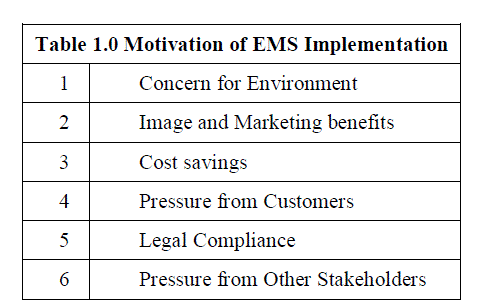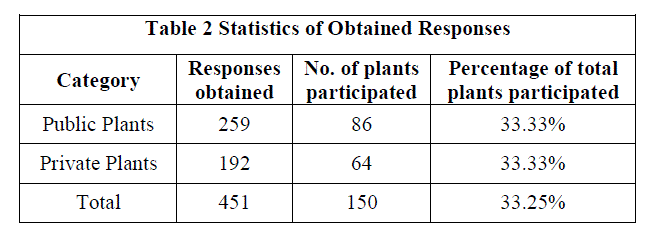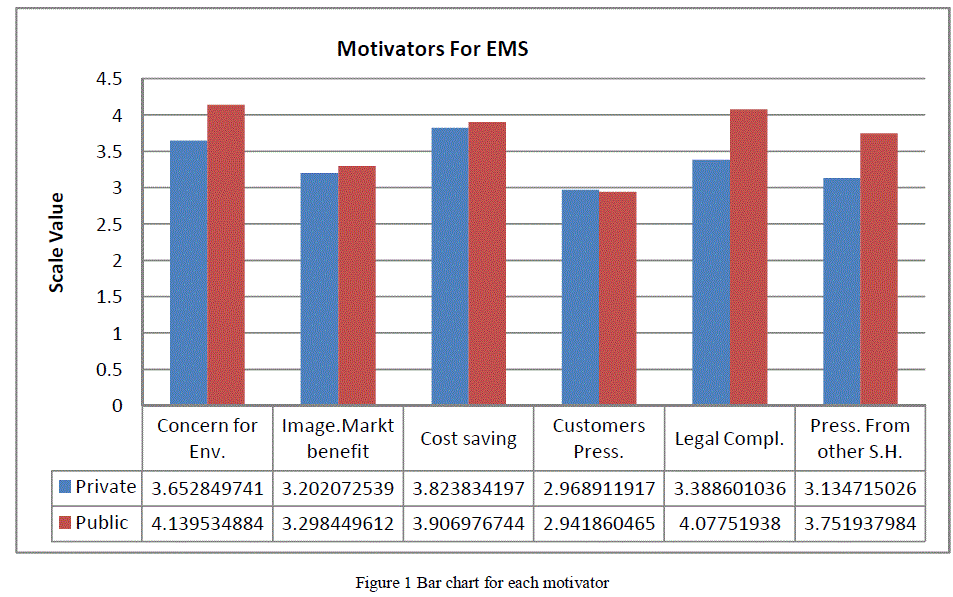ISSN ONLINE(2319-8753)PRINT(2347-6710)
ISSN ONLINE(2319-8753)PRINT(2347-6710)
Jeetendra Kumar Tiwari1, Dr. A.M. Rawani2
|
| Related article at Pubmed, Scholar Google |
Visit for more related articles at International Journal of Innovative Research in Science, Engineering and Technology
Environmental management system (EMS) consists of collection of internal policies, assessments, plans and implementation actions affecting the entire organizational unit and its relationships with the natural environment. There are several issues related with EM. However, literature suggest that most of the researchers have dealt with issues like Stake holder's Pressure, Barriers, mechanisms for EM implementation etc. In addition to the above, Motivators for Implementing EMS is also identified as an important issue. EM approach is valuable to cost reduction, efficient utilization of resources, greater motivation of employees and better compliance to social obligations. Motivators behind the adoption of EMS may be large in number, but few critical motivators are: Concern for environment, Image and Marketing benefits, pressure from customers, legal compliance and pressure from other stakeholders. Thermal power plants are pollution prone industries. Impact of power plants on environment has been greatly emphasized in the literature. Therefore, this study aims to assess perception of Motivators for Implementing EMS in Indian thermal power plants. As thermal power plants in India are either private sector plants or public sector plants. Therefore, it is interesting to explore important motivators separately for two sectors. The study revealed that the most important motivator for private sector power plants is cost saving whereas public sectors plants are more motivated because of their concern for environment.
Keywords |
| Motivators, Thermal power plant, Environmental Management. |
INTRODUCTION |
| India as well as world faces many environmental legacies. These include how to deal with the activities that have already been done to pollute the atmosphere, how to reduce emissions that are still occurring and what to do with resources and waste products that have been used and then dispersed into landfill sites or just left to decay (or not).Environmental Management (EM) has become one of the preferred and most concerned topics for various macroscopic research studies in India and abroad. An environmental management system (EMS) consists of collection of internal policies, assessments, plans and implementation actions [1], affecting the entire organizational unit and its relationships with the natural environment It is also one among the most debated and mused over topic which is raised at various social, political and industrial organizations; but up to what extent these are actually being practiced in various industries is all that counts. However in the last few years, there has been a growing awareness for the environmental issues and it is also realized widely that the environment is not a permanent asset. |
| Power generating units are mega project, which require not only huge capital investment but also various natural resources like, fossil fuels and water thus create an immeasurable & everlasting impact on the environment and generate tremendous stress in the local eco-system in spite of stringent government norms to control and mitigate the damages to the environment by the power plants. The main emissions from coal combustion at thermal power plants are carbon dioxide (CO), nitrogen oxides (NO), sulfur oxides (SO), chlorofluorocarbons (CFCs), and air- borne inorganic particles such as fly ash, soot, and other trace gas species. Carbon dioxide, methane, and chlorofluorocarbons are greenhouse gases. These emissions are considered to be responsible for heating up the atmosphere, producing a harmful global environment. . Large amount of Sox, Nox & SPM are generated which damage the environment and are highly responsible for deterioration of health of human beings, animal kingdom as well as plants. |
| The thermal power plants generate significantly large quantities of solid waste namely fly ash. At present, the disposal of generated fly ash is either by wet disposal or dry disposal. However, there is need to address the problems encountered during the disposal. |
II. LITERATURE REVIEW |
| There are several issues related with EM, but literature review over the past ten to fifteen years suggest that most of the researchers have dealt with issues like Stake holder's Pressure, Barriers, mechanisms for EM Implementation and many others. This research study focuses only to one environmental concern variables i.e. motivators for implementing EMS. The views of the past researchers, present researchers have been incorporated. |
| In spite of the various difficulties, a significant number of industries have been able to obtain certification according to ISO 14001. In fact, many are positively responding to environmental management voluntary schemes as long as they develop. What reasons are motivating these enterprises to implement an EMS? Scholars have identified several factors that could induce an organization to adopt an EMS (either certified or not), and other “pro-active” environmental strategies. In efforts to increase resource productivity while abating costs, an EMS could be adopted to bring about rationalization in the use of inputs (resources) such as energy and raw materials, and at the same time, to reduce outputs such as waste [2]. Moreover, the adoption of an EMS can improve the reputation and image of a company and, consequently, its relations with customers, investors, local communities and other stakeholders [6], [4], [2],[5]. |
| Research findings also demonstrated that the regulatory obligations and other external pressures may stimulate proactive behavior at a managerial level and induce the implementation of an EMS [7], [8]. In a recent study, [7], relying on aspects of institutional theory and on a resource-based view of the firm, determined that institutional pressures (i.e. regulatory, market and social pressure), resources and capabilities (i.e. employee commitment and environmental R&D) both encourage a more comprehensive EMS adoption. Moreover, overcoming information asymmetries and complying with increasing legal requirements [6] represent other specific determinants. |
| As an example, we can cite a survey carried out on French EMAS registered organizations [9]: the results, reported below, evidence how the improvement of environmental performance is regarded as the main motivation for EMAS adoption, more important than improvement of image, legal compliance and so on. |
| As reported by the relevant literature on environmental reporting and EMAS statements [10], [11], [12] the willingness to communicate with the stakeholders can be a powerful driver for EMAS participation. Some of the analyzed studies put an emphasis on the fact that, in some cases, EMAS has been preferred over ISO 14001 thanks to the possibility to use and diffuse credibly validated environmental information [11]. The main drivers for ISOcertification in China [13] were reported to be to ensure regulatory compliance, to enhance the firm's reputation, and to improve environmental performance, in that order, while motivation to achieve cost reductions is less emphasized. |
| Literature suggests that there are many motivators for EM implementations. For our study, we have clubbed similar motivators together. Finally only six most important motivators are identified and are listed in Table 1 below. |
 |
III. OBJECTIVE OF STUDY |
| The objective of this research is to study importance of motivators for implementing environmental management in thermal power plants of India. In India, thermal power plants are either public sectors plants or private sector power plants. Hence it will be interesting to explore motivators for theses two sectors separately and to observe difference in importance of motivators, if any. |
IV. RESEARCH METHODOLOGY AND DATA COLLECTION |
| Questionnaire survey is used to collect data from power plants. Five point Likert scale was used to obtain perception of respondents for importance on each identified motivators. |
| The scope of the proposed research is confined to a particular category of organization i.e. thermal power plants of the country. It is necessary to select a sample that is true representation of the population in order to generalize the results. The population being considered in this research, has been divided into two strata namely, public sector plants and private sector plants. Many thermal power plants in India are of very low capacity. Therefore, it is decided to limit this study on the plants having capacity more than 100 MW. Questionnaire was administered along with a covering letter mentioning the objectives of study. Ten sets of questionnaire were mailed to EM head of the plant with the request to respond. EM head of all plants were requested to get the responses from senior executives of EM and operations department of their plant and return the same to us. About 2-3 weeks later, follow up calls were made to those who have not responded to persuade them to respond. A follow up mailing was also carried out about one month from the date of initial mailing. Personal visits were also arranged wherever convenient. |
| Finally, 515 responses were received from 150 plants. Out of these, 64 questionnaires were about half filled, therefore not considered for further processing. 451 responses are found valid and included in the study. Table 2 presents the statistics of plants participated and number of valid responses obtained. The respondents are fairly well distributed across plant sectors, thereby providing greater generalizability of the results. Table 3 and 4 presents the profile of the respondents indicating their designation and length of experience. Profile of respondents indicates that a significant number of them are senior executives, thereby providing greater credibility and validity of the data. |
 |
V. RESULTS AND DISCUSSION |
| Total 451 valid responses are received from 150 power plants. It means we have multiple responses from one plant. Therefore, first the averages score of all six items for the selected variable for a particular plant is calculated by taking the mean of the scores obtained from all the respondents of that particular plant. Thereafter, mean value of all six items for each sector is calculated by taking average of scores of all plants in that sector. Respondents were asked to indicate the factors that motivated them to implement environmental management system. Average scores for each sector are then plotted in Bar chart for each motivator. Bar chart is shown in figure 1. Figure 1 indicates that the most important motivator for private sector power plants is cost saving whereas public sectors plants are more motivated because of their concern for environment. This matches with general thinking that any activity of private sector organization is done primarily for cost saving. Second important motivator for private sector plant is concern for environment whereas second important motivator for public sector plants is to comply with legal issues. Results indicate that respondents of both public and private sector plants believe pressure from customers as the least important motivator. This leads us to a conclusion that customers of power plants are not putting sufficient pressure to motivate plants for better environmental management. |
 |
VI. CONCLUSIONS |
| This study explores the important motivators for implementation of environmental management practices in thermal power plants in India. The study is limited to thermal power plants only because they are pollution prone industries. Impact of power plants on environment has been greatly emphasized in the literature. Study suggests that plants do not perceive their customer pressure as an important motivator for environmental management. This is probably because of the fact that customers are not well aware of environmental issues linked with thermal power plants. Results, in turn emphasizes on the need of making customers of power plants more aware about environmental issues. Government agencies are always behind power producing units and ask them to adopt environmental management practices. They should also make the customers more aware about environment so that customers create pressure on power plants to adopt good environment practices. Eventually, desired goal of maintaining better environment can be easily achieved. |
References |
|